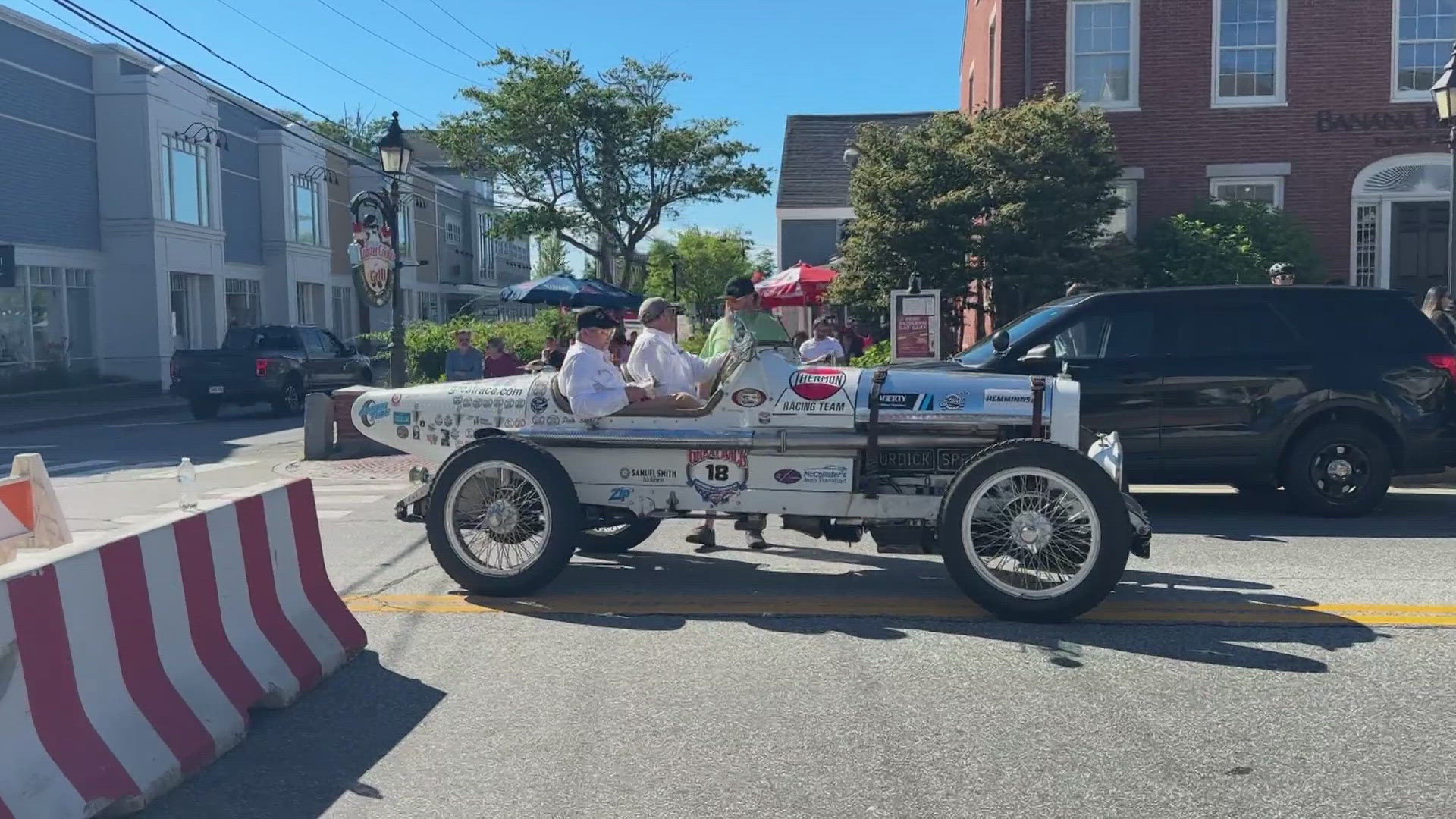FREEPORT, Maine — Jim Stewart and his wife drove to Freeport from Wiscasset, in their early 50’s MG-TD sports car, to get a glimpse of about 140 other classic cars.
“You drive down the road today and you can’t tell one car from another. Look at classic cars and they all have unique body styles. They’re just beautiful to look at and so much fun to drive,” said Stewart.
The couple was perched on a seat along the town’s Main Street, where the cars of the Great Race were making their entrance to Maine. The race is actually a rally, based on time and precise driving instead of speed. This year’s Great Race lasted 9 days, beginning in Kentucky and winding its way to Maine on day 7. The day ended in Freeport, while day 8 took the cars and support teams to Seal Cove on Mount Desert Island, then to the Owls Head Transportation Museum near Rockland. Day 9 took the cars and race teams through central Maine, ending the race in downtown Gardiner.
The event has been held annually for the past 40 years, with a different route each year. The cars and trucks that enter must be at least 50 years old, but many are much older. Peter Brown and Susan Nourse of Freeport drove their 1930 Ford Model A, customized with a wooden “boat tail” back end that makes the car unique. This was the couple’s sixth time participating in The Great Race, inspired, they say by a love for driving old cars. They own several.
“I’m driving my car all the time,” Susan, Freeport’s former police chief, said. “I rarely use my modern car. It’s a wonderful car, but I just like to ride in my Model A.”
Brown and Nourse were one of ten Maine teams in this year’s race. Another was the 1931 REO race car, driven by Charles Harris and Phil Reinhardt. This was Harris’ third time running the Great Race in the REO, his fifth time overall. For Reinhardt, who is the car’s mechanic as well as the navigator, it was the second run in the REO.
At the end of day 8, they rolled into the Owls Head Transportation Museum after a good day on the road.
Reinhardt said the open, 2-seat car had done very well all week, with only one important repair.
“One day the bolt that holds the accelerator broke…at the finish line, five seconds after the finish line. It couldn’t happen in a better place.”
On the final day, however, the pair had a near disaster out on the course, when the car’s fuel pump quit.
“We lost the fuel pump 10 seconds after the restart, “ Harris related. “And Philip, the navigator and mechanic, had installed a backup fuel pump three years ago that we never switched on. I just about had a heart attack when the car died, but he flipped the switch and it came back to life. And it seemed like a week, but it cost us a second and a half and we got it back.”
The cars attracted significant crowds at each of the Maine stops, with people filling downtown Gardiner’s Water Street on the final day.
That put a smile on the face of Peter Prescott, one of Maine’s leading classic car collectors, and a veteran of The Great Race himself. Prescott is also the one who persuaded race organizers to have this year’s race wind up in Maine and his city of Gardiner.
“Because I think it's a great thing, good for the economy and the people. And I want the people to see it,” Prescott said.
He had a simple explanation of why the race attracts big crowds.
“People love cars,” he said.
Prescott’s own ’48 Ford, with a huge lobster decal on the hood, was the first to cross the finish line in Gardiner, a nod by race organizers to the hometown crowd.
Driver Ed Chapman and navigator Guy McCorr have run many previous races in the same car.
“The car did great, we did pretty well,” laughed Chapman. “Glad to be back home.”
The 2,300-mile race is exhausting for the teams, and McCorr said there isn’t much chance to look at the scenery. The teams are given a thick packet of papers each day, 30 minutes before the start, and that tells them the route they will follow. There are no maps, no GPS—just a series of instructions on where to turn and how fast to go for how long.
"Here we will keep our eyes open for a 4-way intersection," McCorr explained, as he showed the series of instructions the team was given on the final day. "Then take a left, go 30 miles an hour, then take a right, go 40 miles an hour…and then look for a sign and take this here, we do this all day long."
One racer had said it was the most mentally exhausting thing he had ever done.
Charles Harris agreed. But was already thinking about next year.
“I used to race late model stock cars…but to me, this [Great Race] is far more challenging and stressful than when someone is pounding into your bumper at 100 mph. “
The 5-time great racer then summed it up:
“A lot of fun.”
Race organizers say they are already working on next year’s event, which will start in St. Paul, Minnesota and finish in South Carolina.

